Investigation of Platinum-Group Minerals (PGM) from Othrys Chromitites (Greece) Using Superpanning Concentrates
Abstract
:1. Introduction
2. Materials and Methods
3. Geological Setting
4. PGM Distribution
4.1. Agios Stefanos Sample
4.1.1. Tip Fraction (−400 Mesh)
4.1.2. Tip Fraction (+400 Mesh)
4.1.3. Chromite Fraction (−400 Mesh)
4.2. Tsangli Sample
4.2.1. Tip Fraction (−400 Mesh)
4.2.2. Tip Fraction (+400 Mesh)
4.2.3. Chromite Fraction (−400 Mesh)
5. Mineralogical Characterisation of PGM
6. Discussion
6.1. Advantages to the PGM Study from Their Beneficiation
6.2. Petrogenetic Implications
7. Conclusions
Acknowledgments
Author Contributions
Conflicts of Interest
References
- Augé, T. Platinum-group mineral inclusions in ophiolitic chromitite from the Vourinos Complex, Greece. Can. Mineral 1985, 23, 163–171. [Google Scholar]
- Ferrario, A.; Garuti, G. Platinum-group mineral inclusions in chromitites of the Finero mafic-ultramafic complex (Ivrea-Zone, Italy). Mineral. Petrol. 1990, 41, 125–143. [Google Scholar] [CrossRef]
- Pedersen, R.B.; Johannesen, G.M.; Boyd, R. Stratiform platinum-group element mineralizations in the ultramafic cumulates of the Leka ophiolite complex, central Norway. Econ. Geol. 1993, 88, 782–803. [Google Scholar] [CrossRef]
- Garuti, G.; Zaccarini, F.; Moloshag, V.; Alimov, V. Platinum-group elements as indicators of sulphur fugacity in ophiolitic upper mantle: An example from chromitites of the Ray-Iz ultramafic complex, Polar Urals, Russia. Can. Mineral. 1999, 37, 1099–1115. [Google Scholar]
- Ahmed, A.H.; Arai, S. Platinum-group minerals in podiform chromitites of the Oman ophiolite. Can. Mineral. 2003, 41, 597–616. [Google Scholar] [CrossRef]
- Burton, K.W.; Schiano, P.; Birck, J.L.; Allègre, C.J. Osmium isotope disequilibrium between mantle minerals in a spinel-lherzolite. Earth Planet. Sci. Lett. 1999, 172, 311–322. [Google Scholar] [CrossRef]
- Harvey, J.; Gannoun, A.; Burton, K.W.; Schiano, P.; Rogers, N.W.; Alard, O. Unravelling the effects of melt depletion and secondary infiltration on mantle Re–Os isotopes beneath the French Massif Central. Geochim. Cosmochim. Acta 2010, 74, 293–320. [Google Scholar] [CrossRef]
- González-Jiménez, J.M.; Griffin, W.L.; Gervilla, F.; Proenza, J.A.; O’Reilly, S.Y.; Pearson, N.J. Chromitites in ophiolites: How, where, when, why? Part I. A review and new ideas on the origin and significance of platinum-group minerals. Lithos 2014, 189, 127–139. [Google Scholar] [CrossRef]
- Naldrett, A.J.; Hoffman, E.L.; Green, A.H.; Chou, C.L.; Naldrett, S.R.; Alcock, R.A. The composition of Ni-sulfide ores, with particular reference to their content of PGE and Au. Can. Mineral. 1979, 17, 403–415. [Google Scholar]
- Garuti, G.; Fershtater, G.; Bea, F.; Montero, P.; Pushkarev, E.V.; Zaccarini, F. Platinum-group elements as petrological indicators in mafic-ultramafic complexes of the central and southern Urals: Preliminary results. Tectonophysics 1997, 276, 181–194. [Google Scholar] [CrossRef]
- Walker, R.J. Highly siderophile elements in the Earth, Moon and Mars: Update and implications for planetary accretion and differentiation. Chem. Erde Geochem. 2009, 69, 101–125. [Google Scholar] [CrossRef]
- O’Driscoll, B.; González-Jiménez, J.M. Petrogenesis of the platinum-group minerals. Rev. Mineral. Geochem. 2016, 81, 489–578. [Google Scholar] [CrossRef]
- Kapsiotis, A.; Grammatikopoulos, T.; Zaccarini, F.; Tsikouras, B.; Garuti, G.; Hatzipanagiotou, K. PGM characterization in concentrates from low grade PGE chromitites from the Vourinos ophiolite complex, northern Greece. Appl. Earth Sci. 2006, 115, 49–57. [Google Scholar] [CrossRef]
- Grammatikopoulos, T.; Kapsiotis, A.; Zaccarini, F.; Tsikouras, B.; Hatzipanagiotou, K.; Garuti, G. Investigation of platinum-group minerals (PGM) from Pindos chromitites (Greece) using hydroseparation concentrates. Miner. Eng. 2007, 20, 1170–1178. [Google Scholar] [CrossRef]
- Kapsiotis, A.; Grammatikopoulos, T.A.; Tsikouras, B.; Hatzipanagiotou, K.; Zaccarini, F.; Garuti, G. Chromian spinel composition and platinum-group element mineralogy of the chromitites from Milia area, Pindos ophiolite complex, Greece. Can. Mineral. 2009, 47, 1037–1056. [Google Scholar] [CrossRef]
- Garuti, G.; Zaccarini, F.; Economou-Eliopoulos, M. Paragenesis and composition of laurite from chromitites of Othrys (Greece): Implications for Os–Ru fractionation in ophiolite upper mantle of the Balkan peninsula. Miner. Depos. 1999, 34, 312–319. [Google Scholar] [CrossRef]
- Kapsiotis, A.; Grammatikopoulos, T.A.; Tsikouras, B.; Hatzipanagiotou, K. Platinum-group mineral characterization in concentrates from high-grade PGE Al-rich chromitites of Korydallos area in the Pindos ophiolite complex (NW Greece). Resour. Geol. 2010, 60, 178–191. [Google Scholar] [CrossRef]
- Kapsiotis, A.; Grammatikopoulos, T.A.; Tsikouras, B.; Hatzipanagiotou, K.; Zaccarini, F.; Garuti, G. Mineralogy, composition and PGM of chromitites from Pefki, Pindos ophiolite complex (NW Greece): Evidence for progressively elevated fAs conditions in the upper mantle sequence. Mineral. Petrol. 2011, 101, 129–150. [Google Scholar] [CrossRef]
- Kocks, H.; Melcher, F.; Meisel, T.; Burgath, K.P. Diverse contributing sources to chromitite petrogenesis in the Shebenik Ophiolitic Complex, Albania: Evidence from new PGE- and Os-isotope data. Mineral. Petrol. 2007, 91, 139–170. [Google Scholar] [CrossRef]
- Smith, A.G.; Hynes, A.J.; Menzies, M.; Nisbet, E.G.; Price, I.; Welland, M.J.; Ferrière, J. The stratigraphy of the Othris Mountains, eastern central Greece: A deformed Mesozoic continental margin sequence. Eclogae Geol. Helv. 1975, 68, 463–481. [Google Scholar]
- Smith, A.G. Tectonic significance of the Hellenic-Dinaric ophiolites. In Magmatic Processes and Plate Tectonics; Prichard, H.M., Alabaster, T., Harris, N.B.W., Neary, C.R., Eds.; Geological Society Special Publication: London, UK, 1993; Volume 76, pp. 213–243. [Google Scholar]
- Dijkstra, A.H.; Drury, M.R.; Vissers, R.L.M. Structural petrology of plagioclase peridotites in the West Othrys Mountains (Greece): Melt impregnation in mantle lithosphere. J. Petrol. 2001, 42, 5–24. [Google Scholar] [CrossRef]
- Barth, M.G.; Mason, P.R.D.; Davies, G.R.; Dijkstra, A.H.; Drury, M.R. Geochemistry of the Othris ophiolite, Greece: Evidence for refertilization? J. Petrol. 2003, 44, 1759–1785. [Google Scholar] [CrossRef] [Green Version]
- Barth, M.G.; Gluhak, T.M. Geochemistry and tectonic setting of mafic rocks from the Othris ophiolite, Greece. Contrib. Mineral. Petrol. 2009, 157, 23–40. [Google Scholar] [CrossRef]
- Tsikouras, B.; Karipi, S.; Rigopoulos, I.; Perraki, M.; Pomonis, P.; Hatzipanagiotou, K. Geochemical processes and petrogenetic evolution of rodingite dykes in the ophiolite complex of Othrys (Central Greece). Lithos 2009, 113, 540–554. [Google Scholar] [CrossRef]
- Rigopoulos, I.; Tsikouras, B.; Pomonis, P.; Hatzipanagiotou, K. Determination of the interrelations between the engineering parameters of construction aggregates from ophiolite complexes of Greece using factor analysis. Constr. Build. Mater. 2013, 49, 747–757. [Google Scholar] [CrossRef]
- Malitch, K.N.; Thalhammer, O.A.; Knauf, V.V.; Melcher, F. Diversity of platinum-group mineral assemblages in banded and podiform chromitite from the Kraubath ultramafic massif, Austria: Evidence for an ophiolitic transition zone? Miner. Deposita 2003, 38, 282–297. [Google Scholar]
- Garuti, G.; Zaccarini, F. In situ alteration of platinum-group minerals at low temperature: Evidence from serpentinized and weathered chromitite of the Vourinos complex, Greece. Can. Mineral. 1997, 35, 611–626. [Google Scholar]
- Economou, M.I.; Naldrett, A.J. Sulfides associated with podiform bodies of chromite at Tsangli, Eretria, Greece. Miner. Depos. 1984, 419, 289–297. [Google Scholar] [CrossRef]
- Dijkstra, A.H.; Barth, M.G.; Drury, M.R.; Mason, P.R.D.; Vissers, R.L.M. Diffuse porous melt flow and melt-rock reaction in the mantle lithosphere at a slow-spreading ridge: A structural petrology and LA-ICP-MS study of the Othris Peridotite Massif (Greece). Geochem. Geophys. Geosyst. 2003, 4, 8613. [Google Scholar] [CrossRef]
- Magganas, A.; Koutsovitis, P. Composition, melting and evolution of the upper mantle beneath the Jurassic Pindos ocean inferred by ophiolitic ultramafic rocks in East Othris, Greece. Int. J. Earth Sci. 2015, 104, 1185–1207. [Google Scholar] [CrossRef]
- Brenan, J.M.; Andrews, D. High-temperature stability of laurite and Ru–Os–Ir alloy and their role in PGE fractionation in mafic magmas. Can. Mineral. 2001, 39, 341–360. [Google Scholar] [CrossRef]
- Andrews, D.R.A.; Brenan, J.M. Phase-equilibrium constraints on the magmatic origin of laurite + Ru–Os–Ir alloy. Can. Mineral. 2002, 40, 1705–1716. [Google Scholar] [CrossRef]
- González-Jiménez, J.M.; Griffin, W.L.; Proenza, J.A.; Gervilla, F.; O’Reilly, S.Y.; Akbulut, M.; Pearson, N.J.; Arai, S. Chromitites in ophiolites: How, where, when, why? Part II. The crystallisation of chromitites. Lithos 2014, 189, 140–158. [Google Scholar] [CrossRef]
- Grammatikopoulos, T.A.; Kapsiotis, A.; Tsikouras, B.; Hatzipanagiotou, K.; Zaccarini, F.; Garuti, G. Spinel composition, PGE geochemistry and mineralogy of the chromitites from the Vourinos ophiolite complex, northwestern Greece. Can. Mineral. 2011, 49, 1571–1598. [Google Scholar] [CrossRef]
- Tarkian, M.; Economou-Eliopoulos, M.; Sambanis, G. Platinum-group minerals in chromitites from the Pindos ophiolite complex, Greece. Neues Jahrb. Mineral. Monatshefte 1996, 4, 145–160. [Google Scholar]
- Prichard, H.M.; Economou-Eliopoulos, M.; Fisher, P.C. Contrasting platinum-group mineral assemblages from two different podiform chromitite localities in the Pindos ophiolite complex, Greece. Can. Mineral. 2008, 46, 329–341. [Google Scholar] [CrossRef]
- Tarkian, M.; Naidenova, E.; Zhelyaskova-Panayotova, M. Platinum-group minerals in chromitites from the Eastern Rhodope ultramafic complex, Bulgaria. Mineral. Petrol. 1991, 44, 73–87. [Google Scholar] [CrossRef]
- Tarkian, M.; Economou-Eliopoulos, M.; Eliopoulos, D.G. Platinum-group minerals and tetraauricupride in ophiolitic rocks of Skyros Island, Greece. Mineral. Petrol. 1992, 47, 55–66. [Google Scholar] [CrossRef]
- Prichard, H.M.; Lord, R.A.; Neary, C.R. A model to explain the occurrence of platinum- and palladium-rich ophiolite complexes. J. Geol. Soc. 1996, 153, 323–328. [Google Scholar] [CrossRef]
- Zaccarini, F.; Proenza, J.A.; Ortega-Gutiérrez, F.; Garuti, G. Platinum group minerals in ophiolitic chromitites from Tehuitzingo (Acatlán complex, southern Mexico): Implications for post-magmatic modification. Mineral. Petrol. 2005, 84, 147–168. [Google Scholar] [CrossRef]
- Proenza, J.A.; Zaccarini, F.; Escayola, M.; Cábana, C.; Shalamuk, A.; Garuti, G. Composition and textures of chromite and platinum-group minerals in chromitites of the western ophiolitic belt from Pampeans Ranges of Córdoba, Argentine. Ore Geol. Rev. 2008, 33, 32–48. [Google Scholar] [CrossRef]
- Kelemen, P.B.; Dick, H.J.B.; Quick, J.E. Formation of harzburgite by pervasive melt/rock reaction in the upper mantle. Nature 1992, 358, 635–641. [Google Scholar] [CrossRef]
- Peregoedova, A.; Barnes, S.J.; Baker, D.R. The formation of Pt–Ir alloys and Cu–Pd-rich sulfide melts by partial desulfurization of Fe–Ni–Cu sulfides: Results of experiments and implications for natural systems. Chem. Geol. 2004, 208, 247–264. [Google Scholar] [CrossRef]
- Graham, I.T.; Franklin, B.J.; Marshall, B. Chemistry and mineralogy of podiform chromitite deposits, southern NSW, Australia: A guide to their origin and evolution. Mineral. Petrol. 1996, 57, 129–150. [Google Scholar] [CrossRef]
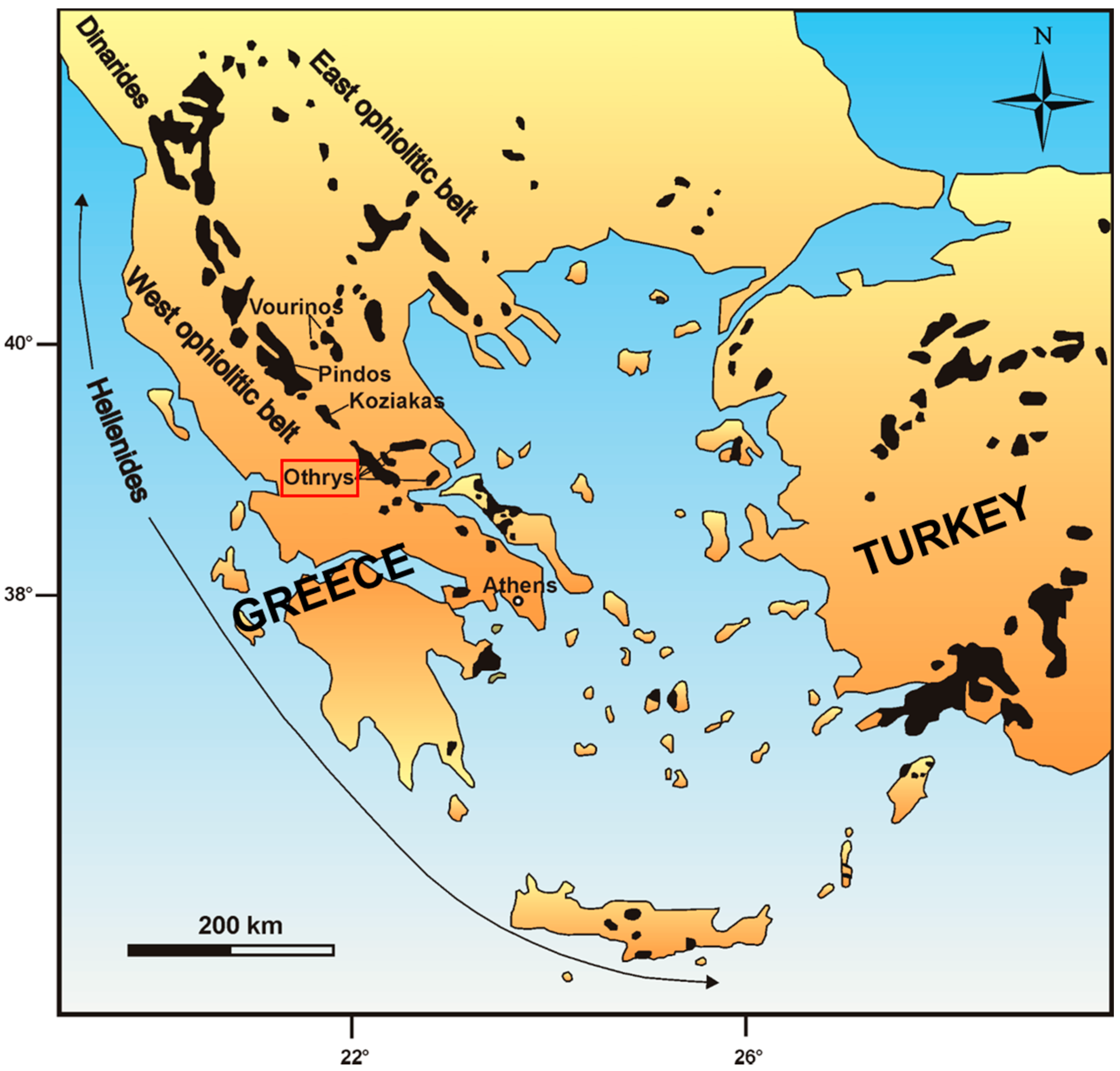
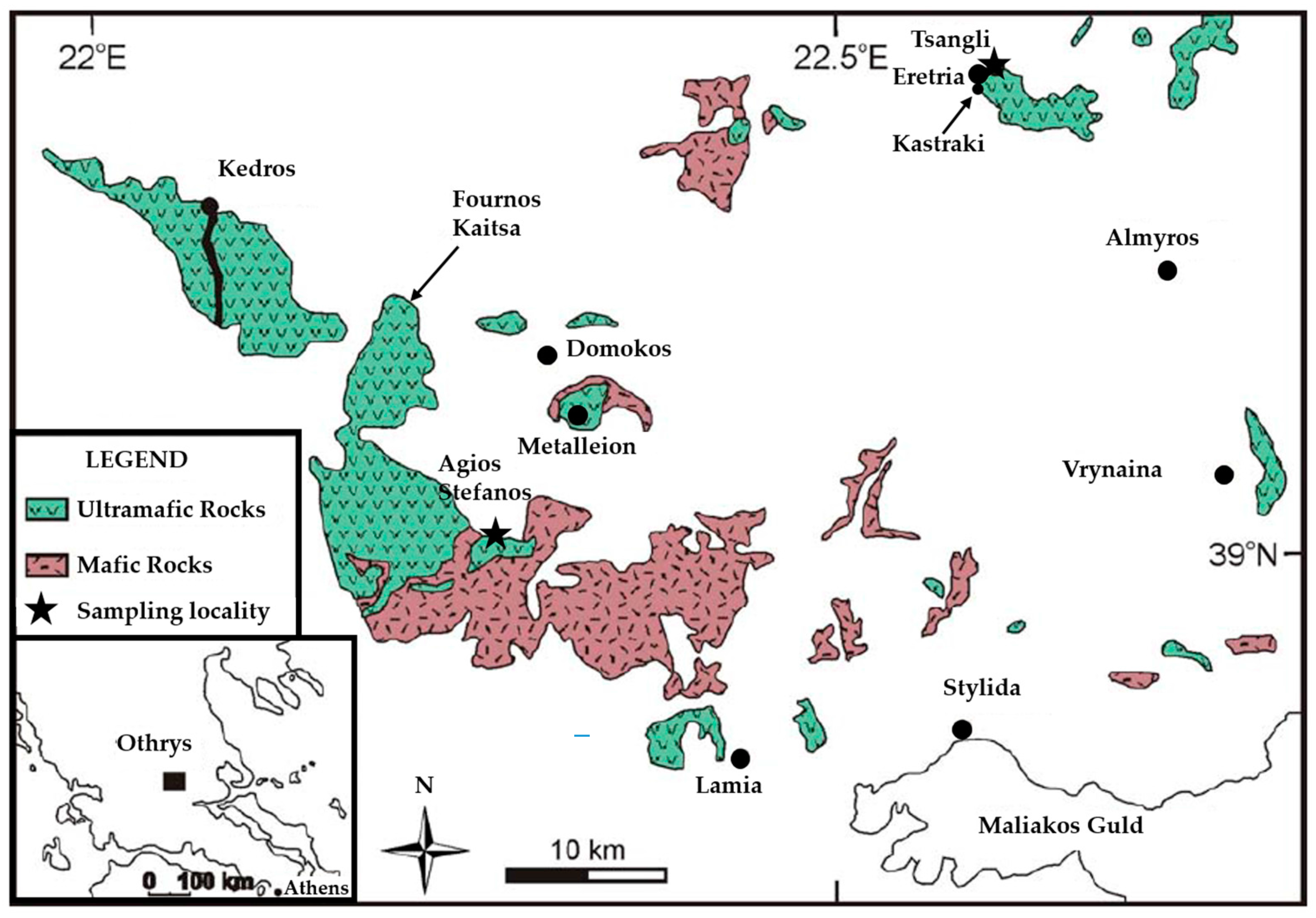
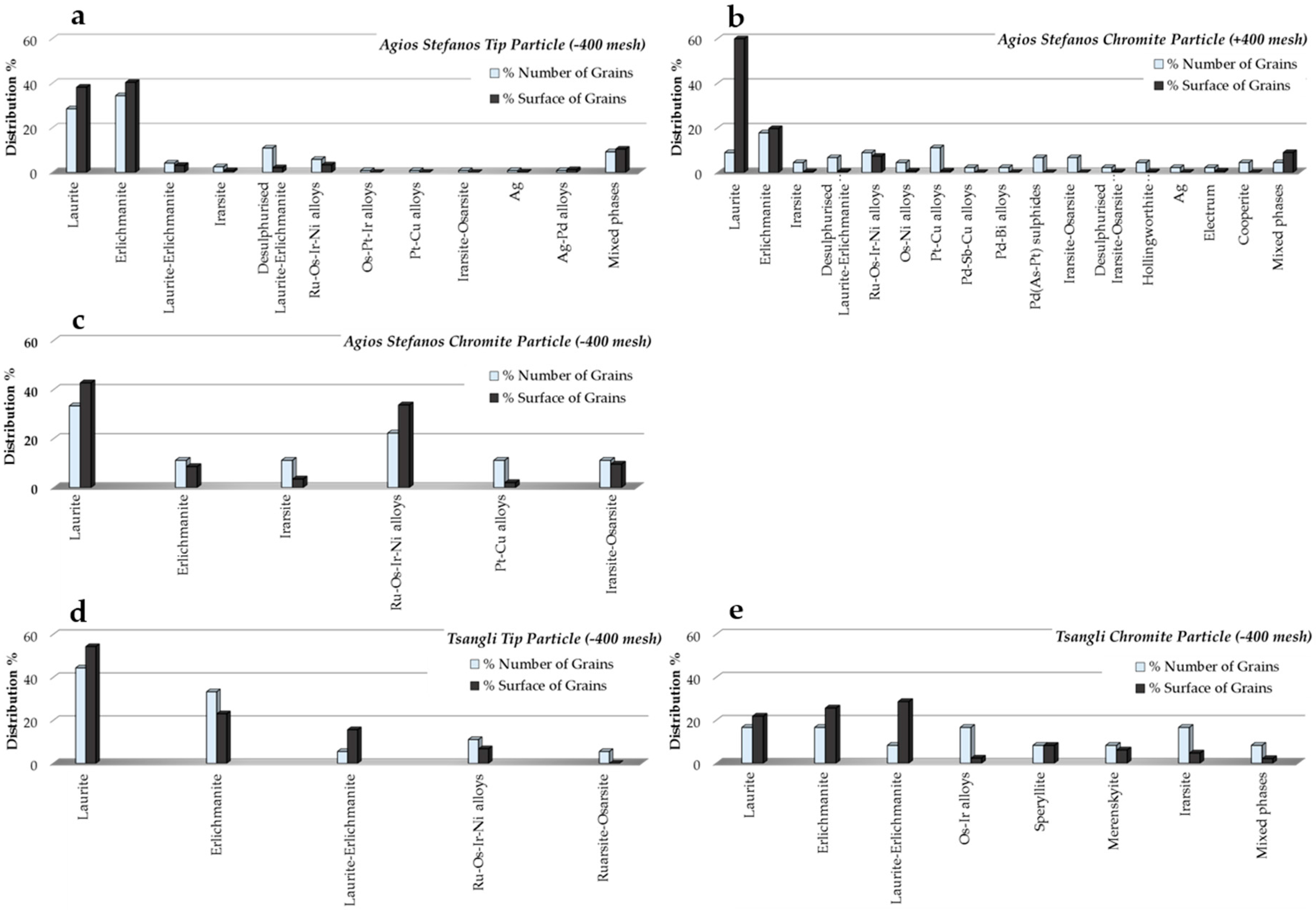
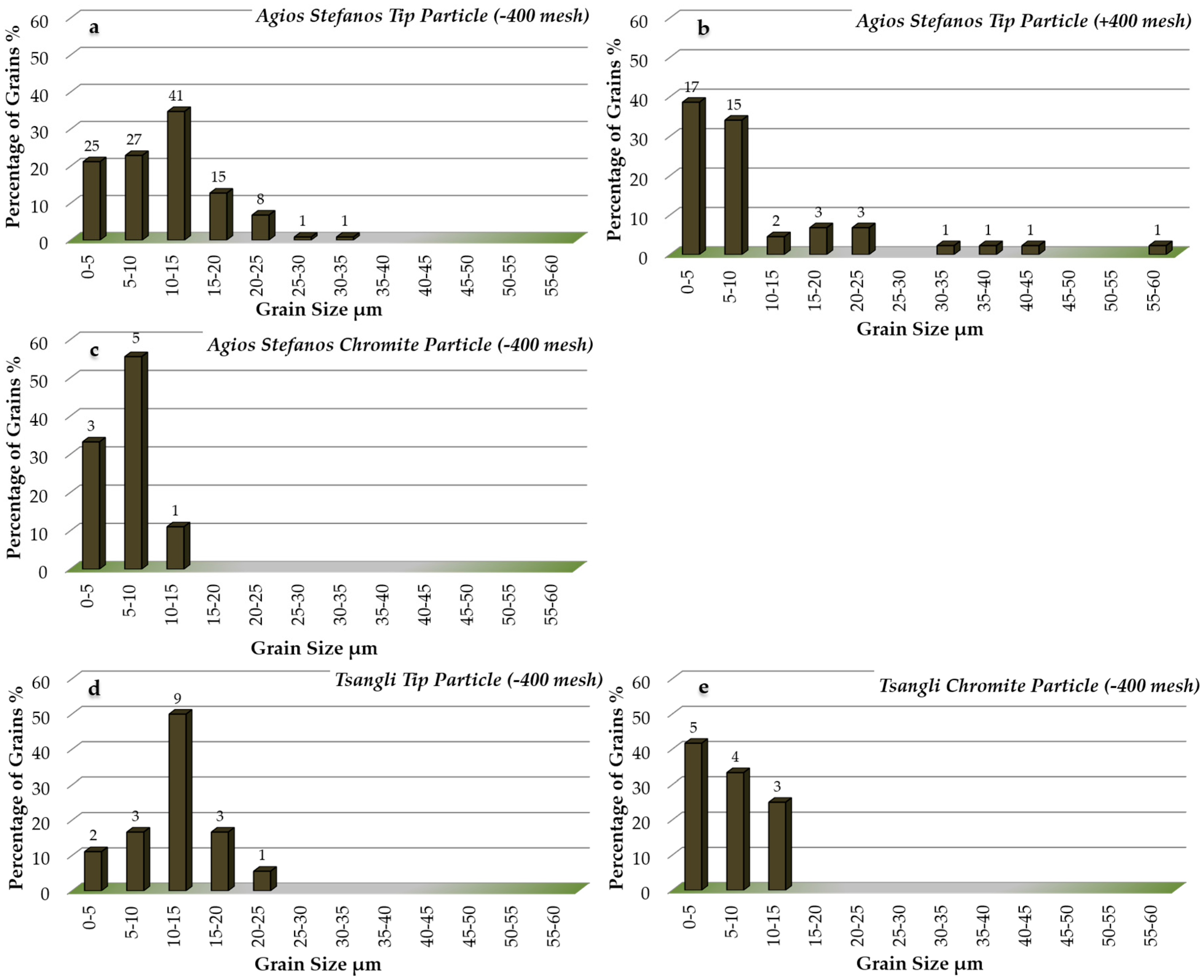

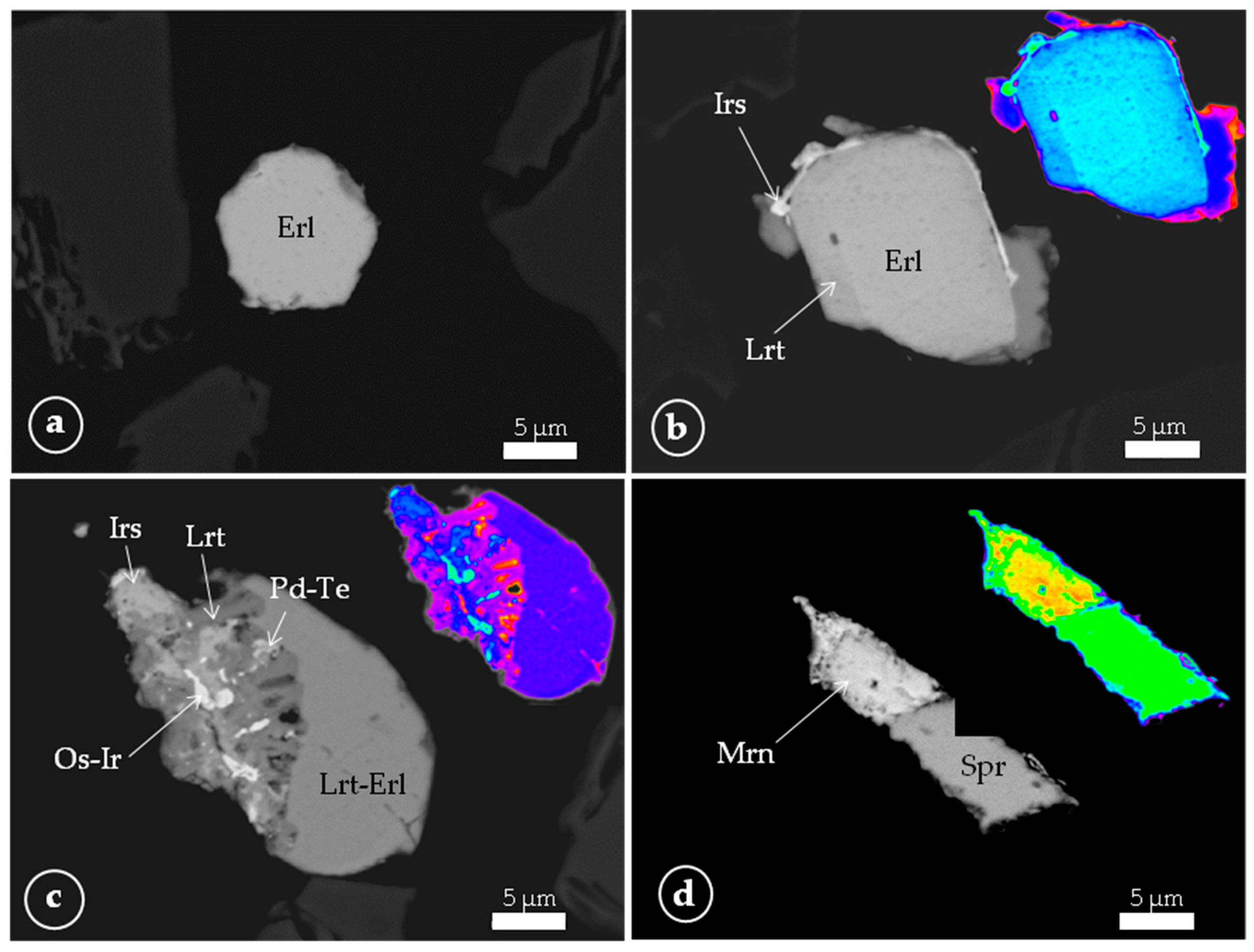
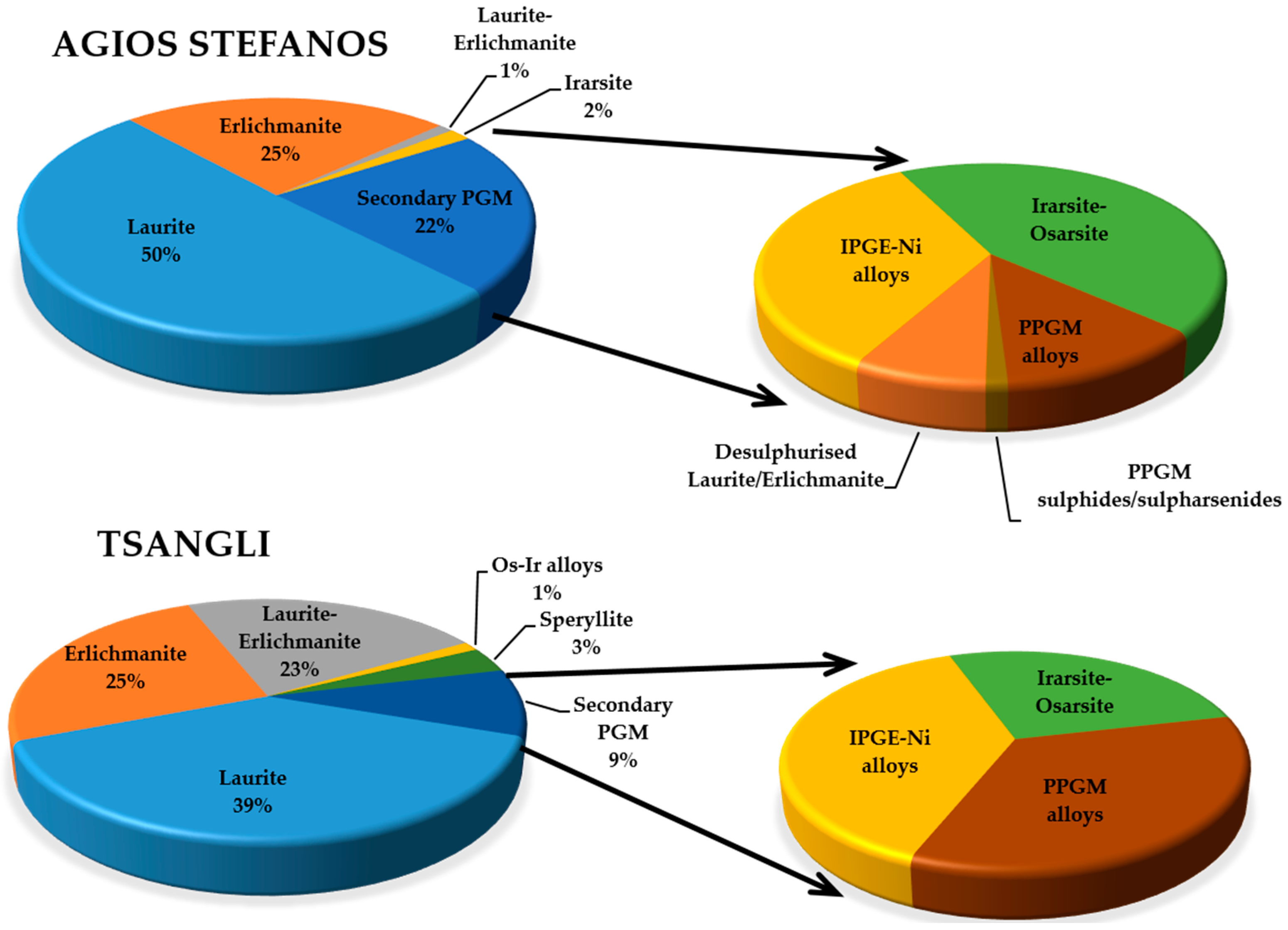
| Minerals | Agios Stefanos | Tsangli | ||||||||||||||||||
|---|---|---|---|---|---|---|---|---|---|---|---|---|---|---|---|---|---|---|---|---|
| Tip (−400 mesh) | Tip (+400 mesh) | Chromite (−400 mesh) | Tip (−400 mesh) | Chromite (−400 mesh) | ||||||||||||||||
| Grains | Area | Grains | Area | Grains | Area | Grains | Area | Grains | Area | |||||||||||
| Number | % | Total um2 | % | Number | % | Total um2 | % | Number | % | Total um2 | % | Number | % | Total um2 | % | Number | % | Total um2 | % | |
| Laurite | 34 | 28.57 | 5475.1 | 38.25 | 4 | 8.89 | 1684.9 | 59.96 | 3 | 33.33 | 108.5 | 42.70 | 8 | 44.44 | 1323.0 | 54.37 | 2 | 16.67 | 117.7 | 21.89 |
| Erlichmanite | 41 | 34.45 | 5787.0 | 40.43 | 8 | 17.78 | 20.1 | 19.71 | 1 | 11.11 | 21.7 | 8.54 | 6 | 33.33 | 561.9 | 23.09 | 2 | 16.67 | 138.0 | 25.66 |
| Laurite-Erlichmanite | 5 | 4.20 | 451.4 | 3.15 | - | - | - | - | - | - | - | - | 1 | 5.56 | 381.8 | 15.69 | 1 | 8.33 | 154.3 | 28.69 |
| Os–Ir alloys | - | - | - | - | - | - | - | - | - | - | - | - | - | - | - | - | 2 | 16.67 | 12.8 | 2.38 |
| Speryllite | - | - | - | - | - | - | - | - | - | - | - | - | - | - | - | - | 1 | 8.33 | 44.7 | 8.31 |
| Desulphurised Laurite | 7 | 5.88 | 57.4 | 0.40 | 1 | 2.22 | 5125.0 | 0.06 | - | - | - | - | - | - | - | - | - | - | - | - |
| Desulphurised Erlichmanite | 5 | 4.20 | 223.3 | 1.56 | 1 | 2.22 | 4.8 | 0.24 | - | - | - | - | - | - | - | - | - | - | - | - |
| Desulphurised Laurite-Erlichmanite | 1 | 0.84 | 18.5 | 0.13 | 1 | 2.22 | 21.3 | 0.25 | - | - | - | - | - | - | - | - | - | - | - | - |
| Ru–Os–Ir–Ni alloys | 7 | 5.88 | 484.2 | 3.38 | 4 | 8.89 | 624.6 | 7.31 | 2 | 22.22 | 85.6 | 33.69 | 2 | 11.11 | 166.0 | 6.82 | - | - | - | - |
| Os–Ni alloys | 2 | 4.44 | 57.7 | 0.68 | - | - | - | - | - | - | - | - | - | - | - | - | ||||
| Irarsite | 3 | 2.52 | 112.7 | 0.79 | 2 | 4.44 | 28.9 | 0.34 | 1 | 11.11 | 8.9 | 3.50 | - | - | - | - | 2 | 16.67 | 25.6 | 4.76 |
| Irarsite-Osarsite | 1 | 0.84 | 0.6 | 0.00 | 3 | 6.67 | 2.9 | 0.03 | 1 | 11.11 | 24.3 | 9.56 | - | - | - | - | - | - | - | - |
| Ruarsite-Osarsite | - | - | - | - | - | - | - | - | - | - | - | - | 1 | 5.56 | 0.6 | 0.02 | - | - | - | - |
| Desulphurised Irarsite-Osarsite | - | - | - | - | 1 | 2.22 | 30.2 | 0.35 | - | - | - | - | - | - | - | - | - | - | - | - |
| Pt–Cu alloys | 1 | 0.84 | 5.5 | 0.04 | 5 | 11.11 | 60.8 | 0.71 | 1 | 11.11 | 5.1 | 2.01 | - | - | - | - | - | - | - | - |
| Os–Ir–Pt alloys | 1 | 0.84 | 1.3 | 0.01 | - | - | - | - | - | - | - | - | - | - | - | - | - | - | - | - |
| Pd–Sb–Cu alloys | - | - | - | - | 1 | 2.22 | 4.6 | 0.05 | - | - | - | - | - | - | - | - | - | - | - | - |
| Pd–Bi alloys | - | - | - | - | 1 | 2.22 | 9.2 | 0.11 | - | - | - | - | - | - | - | - | - | - | - | - |
| Hollingworthite | - | - | - | - | 2 | 4.44 | 32.1 | 0.38 | - | - | - | - | - | - | - | - | - | - | - | - |
| Cooperite | - | - | - | - | 2 | 4.44 | 1.6 | 0.02 | - | - | - | - | - | - | - | - | - | - | - | - |
| Pd(As–Pt) sulphides | - | - | - | - | 3 | 6.67 | 2.6 | 0.03 | - | - | - | - | - | - | - | - | - | - | - | - |
| Merenskyite | - | - | - | - | - | - | - | - | - | - | - | - | - | - | - | - | 1 | 8.33 | 33.2 | 6.17 |
| Ag | 1 | 0.84 | 23.0 | 0.16 | 1 | 2.22 | 13.8 | 0.16 | - | - | - | - | - | - | - | - | - | - | - | - |
| Ag–Pd alloys | 1 | 0.84 | 175.0 | 1.22 | - | - | - | - | - | - | - | - | - | - | - | - | - | - | - | - |
| Electrum | - | - | - | - | 1 | 2.22 | 57.1 | 0.67 | - | - | - | - | - | - | - | - | - | - | - | - |
| Mixed phases | 11 | 9.24 | 1499.3 | 10.47 | 2 | 4.44 | 765.0 | 8.95 | - | - | - | - | - | - | - | - | 1 | 8.33 | 11.5 | 2.14 |
© 2016 by the authors; licensee MDPI, Basel, Switzerland. This article is an open access article distributed under the terms and conditions of the Creative Commons Attribution (CC-BY) license (http://creativecommons.org/licenses/by/4.0/).
Share and Cite
Tsikouras, B.; Ifandi, E.; Karipi, S.; Grammatikopoulos, T.A.; Hatzipanagiotou, K. Investigation of Platinum-Group Minerals (PGM) from Othrys Chromitites (Greece) Using Superpanning Concentrates. Minerals 2016, 6, 94. https://doi.org/10.3390/min6030094
Tsikouras B, Ifandi E, Karipi S, Grammatikopoulos TA, Hatzipanagiotou K. Investigation of Platinum-Group Minerals (PGM) from Othrys Chromitites (Greece) Using Superpanning Concentrates. Minerals. 2016; 6(3):94. https://doi.org/10.3390/min6030094
Chicago/Turabian StyleTsikouras, Basilios, Elena Ifandi, Sofia Karipi, Tassos A. Grammatikopoulos, and Konstantin Hatzipanagiotou. 2016. "Investigation of Platinum-Group Minerals (PGM) from Othrys Chromitites (Greece) Using Superpanning Concentrates" Minerals 6, no. 3: 94. https://doi.org/10.3390/min6030094







